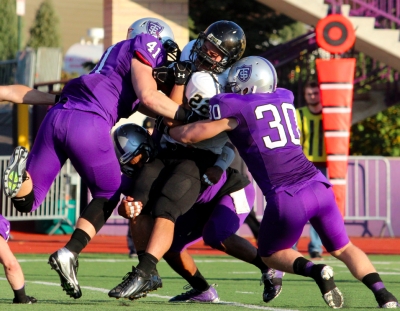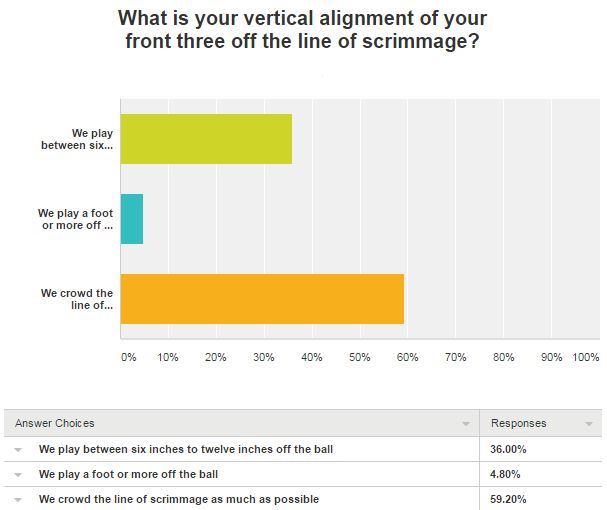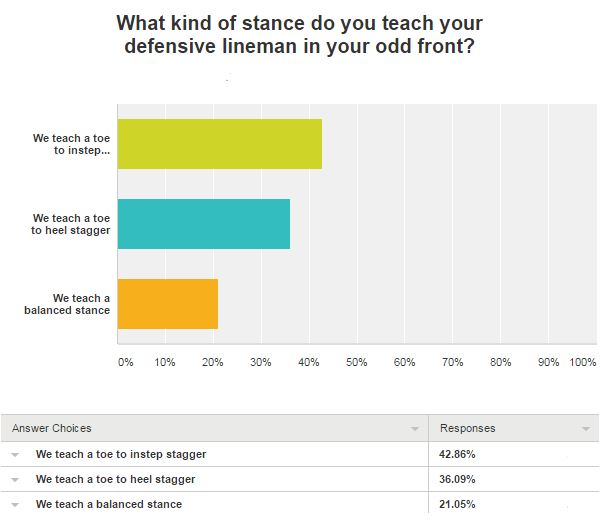By Mike Kuchar
Senior Research Manager
X&O Labs
Twitter: @MikekKuchar
Introduction
 It’s difficult to generate an odd front conversation without the issue of two-gap football surfacing. The odd front is synonymous with two-gap play at the line of scrimmage. From Nick Saban’s system at LSU to Rex Ryan’s system at the Baltimore Ravens (just to name the more prolific examples), the odd front continues to be utilized to defend many of the run game concepts presented at all levels of football.
It’s difficult to generate an odd front conversation without the issue of two-gap football surfacing. The odd front is synonymous with two-gap play at the line of scrimmage. From Nick Saban’s system at LSU to Rex Ryan’s system at the Baltimore Ravens (just to name the more prolific examples), the odd front continues to be utilized to defend many of the run game concepts presented at all levels of football.
We’re aware that many defensive coordinators will find ways to corner an offense into third down to bring those exotic pressures associated with the odd front. But this study is not about that. It’s about living and dying in the odd front in run situations. We’re talking about first down defense, here. Because while it may be exciting to draw up those pressures with three down, the odd front purists that we researched have bought in completely to using this scheme. Our research consists of those coaches who use odd front structures in at least 75 percent or more of run-downs.
We asked these coaches why they use the odd front in run downs. Despite a myriad of reasons, we disseminated the top six frequencies in our research:
Benefits of the Odd Front Against the Run Game
- Opportunity to get your most athletic players on the field: subbing out a defensive lineman for a second level player provides for a more athletic body which helps to defend many of the quarterback run concepts utilized by offenses today.
- Gets more eyes on the quarterback: Similar to that first example, having two hands less in the dirt helps with quarterback vision in both the option game and in the pass game. This study will strictly focus on the former.
- Eliminates angles in gap schemes: With so much of the Ohio State/Ole Miss spread gap scheme concepts circulating football, being in an odd front eliminates possible angles and double teams on the play side of these runs. Odd front coaches are using the two-gap method to negate these blocks.
- Flexibility and disguise pre-snap: What may look like a three-down front pre-snap, 85 percent of odd front coaches are slanting or stemming their front pre-snap to get in different looks by the time the quarterback has the ball in his hands.
- Alternating run fits post-snap: Contrary to the “single gap control” element present in even front structures, the odd front provides for varying run fits simply because it’s difficult to determine whether or not first level players are two-gapping or single-gapping at the point of attack. The majority of coaches, 47 percent, will two gap their defensive linemen some of the time. They alternate between two-gap play and single gap movement. Of course, we detail both these scenarios in case one.
- Increased preparation time for offenses: All this pre and post-snap confusion causes offenses to spend more time trying to attack the odd front.
- A dominant nose can affect the game: We have an entire case on the play of the nose, so we won’t expound too much here. But we will say it’s no surprise that many of these odd front coaches put their best defensive lineman right on the center. With the majority of offense being in shotgun or pistol formations, this player can create havoc if he’s coached right. We will present the drill work that the most successful coaches use to work this kid.
This case will be centered on the varying methodologies between the two-gap and one-gap technique up front. We will examine the techniques associated with each including the circumstances in which coaches use them. We will begin our research with the play of the nose, but before we get into the specifics, we wanted to share some general research among defensive line play.
- 59 percent of coaches choose to have their front three crowd the line of scrimmage as much as possible

- 42 percent of coaches choose to teach a toe to instep stagger among their front three

We wanted to present these issues because they continue to be hot topics among odd front coaches. We will present all methodologies and perspectives on these components, but the responses above were majority answers.
Play of the Nose Guard
There is no question that the success of the odd front is belied upon the success of the defender covering the center. Looking back at the most successful odd front nose guards in the history of football, Vince Wilfork (Patriots), Tony Siragusa (Colts), Gilbert Brown (Packers), Heloti Ngata (Ravens), one can make the somewhat obvious correlation between great defenses and great middle men. So we wanted to reach out to some coaches on how they teach the nose position, being that it’s so vital. Sure, this player may not attain the accolades, but these odd front coaches rave about him being the motor that makes the defense run. Perhaps Coach Pitman at Half Hollow Hills West HS (NY) said it best when he said, “Toughness must be both physical, but especially mental. He is in a position where he determines our success on defense, but will never get outside attention or build up any noticeable stats.”









